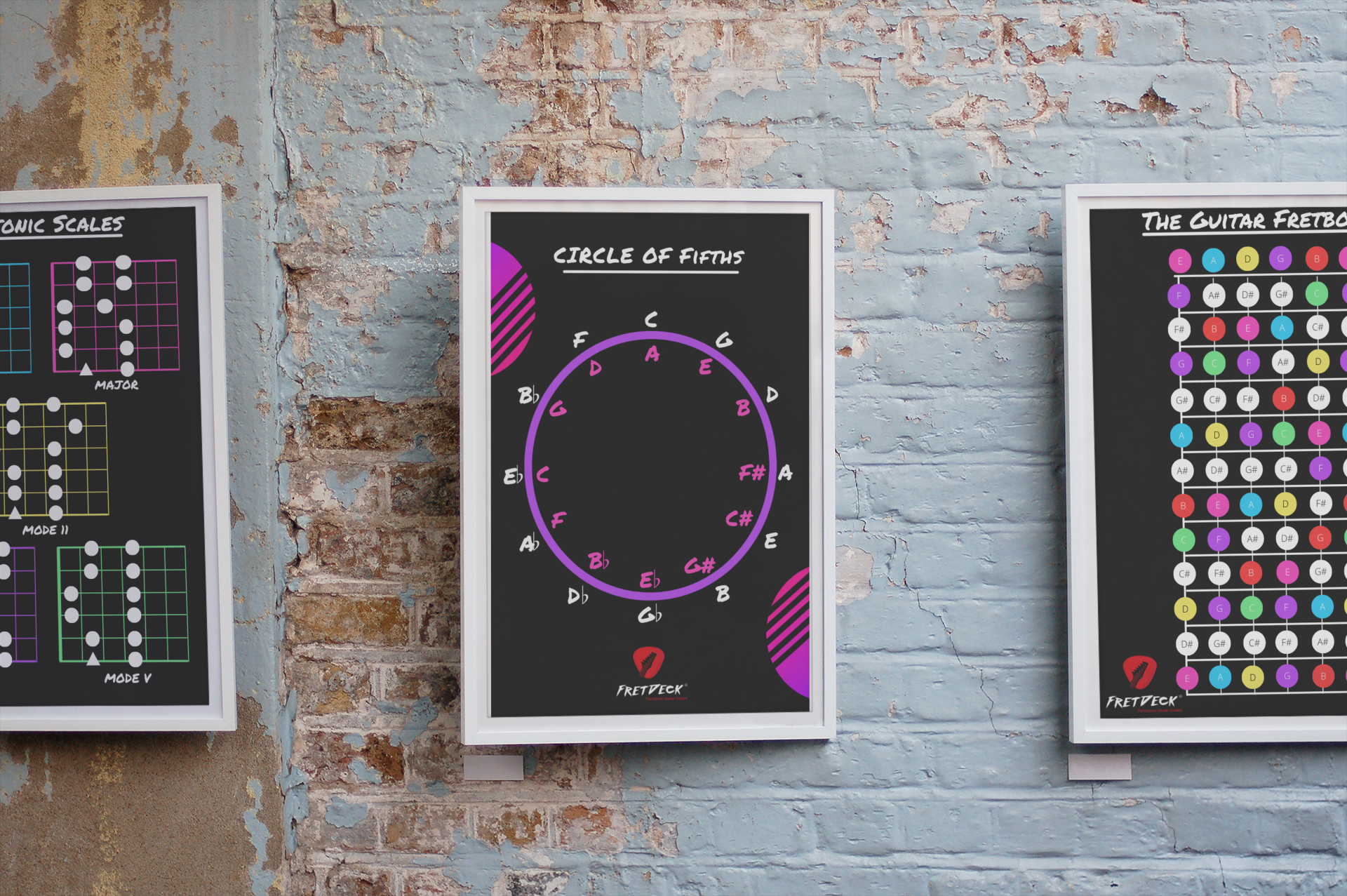The minor pentatonic scale is a go-to tool for guitarists across genres like blues, rock, and jazz. This five-note scale is simpler than major or minor scales, making it versatile for both beginners and advanced players. Once you’ve mastered minor pentatonic scale patterns across the fretboard, you’ll gain the ability to solo freely, link shapes effortlessly, and add musical phrasing with confidence.
Whether you’re just learning the basics or seeking to refine your skills, mastering the minor pentatonic scale is key to unlocking the fretboard. Here, we’ll explore essential minor pentatonic patterns, techniques for connecting shapes, and ways to incorporate these patterns into your improvisation.
Why Master the Minor Pentatonic Scale?
The minor pentatonic scale is popular because of its versatility and simplicity. Made up of only five notes (1, b3, 4, 5, and b7), it eliminates some of the potential “wrong notes” found in larger scales, making it sound good even when played over complex chord progressions. Its sound is straightforward, with a bluesy quality that gives character to solos in rock, blues, metal, and even jazz.
Mastering this scale across the fretboard means that you can improvise anywhere, connect patterns, and build solos without feeling limited to one area of the neck. A strong grasp of the minor pentatonic scale patterns also opens doors to exploring major pentatonic scales and other modes, making it a foundational tool for players of all levels.

Download FREE Guitar Charts!
We have 27 FREE guitar charts to help you learn the guitar fretboard. Learn How to play chords and scales with these free resources.
Free Guitar Resources
Understanding the Five Minor Pentatonic Scale Patterns
When playing the minor pentatonic scale across the fretboard, we rely on five interconnected patterns, or “shapes,” that allow smooth transitions up and down the neck. While each pattern contains the same five notes, each has a unique structure and placement on the fretboard.
Pattern 1 (Root on Low E String)
The first minor pentatonic pattern is the most familiar to most players. For example, in A minor, this shape has the root note (A) on the 5th fret of the low E string. This foundational shape is often the starting point for beginners and is widely used for its ease and familiarity.
Pattern 2
Pattern 2 begins from the second note of Pattern 1. If you’re in A minor, this pattern starts on the 8th fret and covers a slightly higher position. This shape links with Pattern 1 below it and Pattern 3 above, allowing players to “shift gears” on the fretboard seamlessly.
Pattern 3
Pattern 3 starts with the third note of Pattern 1, extending the scale further up the neck. In A minor, this pattern begins on the 10th fret and provides more range for playing higher notes while staying in the pentatonic structure.
Pattern 4
Continuing up the fretboard, Pattern 4 connects with Pattern 3 below it and Pattern 5 above. This pattern allows you to navigate mid-neck positions with ease and is particularly useful when soloing in higher octaves.
Pattern 5
The fifth and final pattern brings the scale full circle, completing the cycle. Once you’ve learned all five patterns, Pattern 5 loops back to connect with Pattern 1, allowing you to navigate the fretboard fluidly from low to high positions.
Step-by-Step Approach to Learning Minor Pentatonic Patterns
To master these five minor pentatonic patterns, start by familiarizing yourself with each shape individually. Begin with Pattern 1, playing it slowly to ensure clean note transitions, then add one new pattern at a time. Here’s a recommended progression for efficient learning:
- Start with Pattern 1: This is the most common starting point, so practice it until it feels comfortable.
- Introduce Pattern 2: Once Pattern 1 feels natural, add Pattern 2 and practice connecting the two shapes.
- Practice Up the Fretboard: Continue to add each pattern until you can play all five without stopping.
- Work with a Metronome: Playing with a metronome at a steady tempo will build accuracy and timing. Gradually increase your speed as you gain confidence.
- Transition Between Patterns: Focus on smooth transitions from one shape to the next, using slides or shifts as needed.
Learning the patterns in this order helps build muscle memory, ensuring that you’re not just memorizing notes but understanding how each pattern connects across the fretboard.
Techniques for Connecting Minor Pentatonic Scale Patterns
Knowing each pattern individually is crucial, but the real advantage comes when you can link them fluidly. Here are key techniques to make transitions between minor pentatonic patterns feel effortless:
- Sliding Transitions: A simple slide from one position to the next can smoothly connect shapes. Try sliding from the last note of Pattern 1 to the first note of Pattern 2, and continue this approach as you ascend.
- Octave Shifts: Octaves are powerful tools for connecting across the fretboard. Practice starting with one pattern, then jump up an octave to another pattern. This is especially effective when soloing, as it provides a fresh tonal shift without changing scale.
- Diagonal Playing: Rather than moving strictly vertically or horizontally, diagonal playing allows you to move through multiple shapes while moving up or down the neck. This technique offers a more dynamic sound and is ideal for lead playing.
- Phrasing Techniques: Techniques like bends, slides, and hammer-ons give character to the pentatonic scale. Practice adding these to each pattern, and try using them as you move between shapes to keep your playing expressive.
Incorporating Minor Pentatonic Scales into Improvisation
To make the most of the minor pentatonic scale, try applying it in real musical settings. Begin by practicing over a simple backing track in a minor key, like A minor. Start with Pattern 1 and gradually integrate additional patterns, transitioning seamlessly. Here are some ideas to help you use these patterns creatively:
- Experiment with Dynamics: Try playing softly, then build intensity to create contrast.
- Add Rhythm Variations: Vary your note duration, using longer-held notes for emphasis and quick runs for excitement.
- Use Silence: Leaving space between phrases can create anticipation and add structure to your solos.
- Explore Licks and Riffs: Incorporate classic pentatonic licks, blending them with your own ideas. Practice these licks across multiple patterns to make your soloing smoother.
The more you practice incorporating these elements, the more natural your soloing will feel. Each session will help develop your phrasing and rhythm control.
Building a Practice Routine for Mastery
Building a routine that incorporates minor pentatonic patterns, transition exercises, and improvisation will ensure steady progress. Here’s a sample routine you can use daily:
- Warm-Up with Scales: Spend 5–10 minutes running through all five minor pentatonic patterns slowly, focusing on clean note transitions.
- Practice Transitions: Spend another 10 minutes linking two or more patterns, focusing on slides and diagonal shifts.
- Backing Track Practice: Improvise over a backing track for 10–15 minutes, switching between patterns to develop comfort with fretboard navigation.
- Recording and Reflection: Record a few minutes of your improvisation and listen back to identify areas for improvement.
By consistently following this routine, you’ll gradually master the minor pentatonic scale across the fretboard, developing both technical skill and musicality.
Mastering minor pentatonic scale patterns across the fretboard will give you a foundation for expressive, versatile guitar playing. Whether you’re drawn to blues, rock, jazz, or metal, a solid command of these patterns will help you unlock new creative possibilities. For further guidance, check out FretDeck’s courses, which provide step-by-step guidance on fretboard mastery, helping players connect shapes and build solos with confidence.

Download FREE Guitar Charts!
We have 27 FREE guitar charts to help you learn the guitar fretboard. Learn How to play chords and scales with these free resources.
Free Guitar Resources










